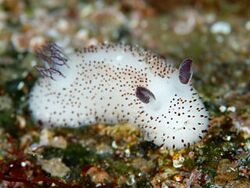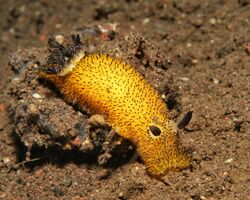Biology:Jorunna parva
| Jorunna parva | |
|---|---|

| |
| Jorunna parva | |
| Scientific classification | |
| Kingdom: | |
| Phylum: | |
| Class: | |
| Order: | |
| Family: | |
| Genus: | |
| Species: | J. parva
|
| Binomial name | |
| Jorunna parva (Baba, 1938)[1]
| |
| Synonyms[2] | |
|
Thordisa parva Baba, 1938 | |
Jorunna parva, commonly known as the sea bunny, is a species of dorid nudibranch, a shell-less marine gastropod mollusc in the family Discodorididae. The species was first described by Kikutaro Baba.[2] Its resemblance to a rabbit facilitated a surge in popularity on Twitter throughout Japan in 2015.[3]
Description
The species is about 1 cm long on average. Its black-and-white rhinophores somewhat resemble a rabbit's ears. Its external gills are located near its rear. Its body is covered in papillae, fleshy protuberances used for sensory functions, giving it the appearance of a furry animal.[4] There are multiple colorations of Jorunna parva, including yellow, white, and green, though the latter is rarely photographed.[5] All of these variants have black papillae interspersed among papillae of their main color. There is controversy over whether or not the different colorations are divergent species.[5]
Like most other members of its genus, Jorunna parva's diet consists of toxic sponges in the family Chalinidae. These sponges contain toxins that can be used for cancer treatments.[6]
Jorunna parva are hermaphrodites, meaning they produce both sperm and egg cells. They cannot fertilize the eggs themselves.[5]
Distribution
This species was described from Kii Province, Japan . Jorunna parva has subsequently been reported from the Philippines , Tanzania, Papua New Guinea, Seychelles and Réunion but there are some doubts as to whether it is really a species complex.[7] The Jorunna parva are concentrated in areas where there is an abundance of food and where resources are easily acquired.[8] They often cling to submerged vegetation and spend majority of the time at the bottom of tropical waters.[9]
References
- ↑ Baba, K. (1938) Opisthobranchia of Kii, Middle Japan. Journal of the Dept of Agriculture, Kyushu Imperial University, 6(1): 1–19.
- ↑ 2.0 2.1 Bouchet, P. (2010). Jorunna parva (Baba, 1938). World Register of Marine Species.
- ↑ Kearns, Landess (July 15, 2015). "Fluffy Bunny Sea Slugs Make Us Want To Cuddle Them". Huffington Post. http://www.huffingtonpost.com/entry/fluffy-bunny-sea-slugs_55a6cb53e4b0896514d04233.
- ↑ Dr. M (July 19, 2015). "The Science of Sea Bunnies: You'll Never Believe The Top Ten List We Created To Get You To Visit Our Website.". http://www.deepseanews.com/2015/07/the-science-of-sea-bunnies-youll-never-believe-the-top-ten-list-we-created-to-get-you-to-visit-our-website/.
- ↑ 5.0 5.1 5.2 Badore, Margaret (July 20, 2015). "The adorable science behind the "sea bunny"". https://www.treehugger.com/natural-sciences/adorable-science-behind-sea-bunny.html.
- ↑ "Meet the Adorable "Sea Bunny" Taking Over the Internet". 2015-07-23. https://news.nationalgeographic.com/2015/07/150723-sea-slug-nudibranch-sea-bunny-ocean-animals-science/.
- ↑ Rudman, W.B., 2000 (July 4) Jorunna parva? (Baba, 1938). [In] Sea Slug Forum. Australian Museum, Sydney.
- ↑ M, Dr (2015-07-19). "The Science of Sea Bunnies: You'll Never Believe The Top Ten List We Created To Get You To Visit Our Website." (in en-US). http://www.deepseanews.com/2015/07/the-science-of-sea-bunnies-youll-never-believe-the-top-ten-list-we-created-to-get-you-to-visit-our-website/.
- ↑ "Sea Slug | Encyclopedia.com". https://www.encyclopedia.com/plants-and-animals/animals/zoology-invertebrates/sea-slug.
- Camacho-García Y.E. & Gosliner T.M. (2008). Systematic revision of Jorunna Bergh, 1876 (Nudibranchia: Discodorididae) with a morphological phylogenetic analysis. Journal of Molluscan Studies 74: 143–181
Wikidata ☰ Q13373630 entry
 |



